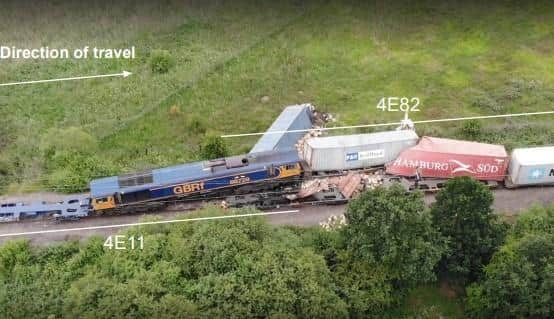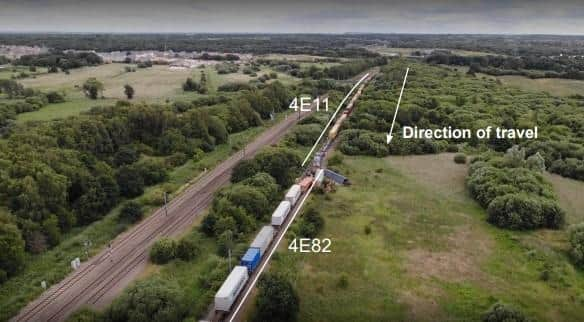Loversall Junction Doncaster rail crash: Report finds that collision between two freight trains in Yorkshire was caused by driver with undiagnosed sleep condition being awake for 21 hours
The crash happened last July at the Loversall Carr Junction just after 6am, when one of the trains, travelling from Felixstowe to the Masborough terminal near Rotherham, left the East Coast Main Line and passed a red signal at danger.
The locomotive and its 35 wagons struck the rear of a Freightliner train bound for Sheffield waiting in the section ahead, which was being protected by the signal, at a speed of 28mph.
Advertisement
Hide AdAdvertisement
Hide AdThe collision caused a derailment, significant damage to the rolling stock and track, and led to a 26-day route closure.


Although both drivers were unhurt, it was found that the driver of the moving train experienced a ‘loss of awareness of the driving task’ likely due to tiredness, and perhaps because of a low workload on approach to the junction and an expectation based on previous journeys of what the signal would show.
The RAIB investigation identified the driver’s work pattern as a primary cause of the fatigue, as they had experienced a ‘low quality of rest’ attributed to an undiagnosed sleep condition which had not been detected in health assessments by GB Railfreight.
The company’s management of fatigue was deemed not to follow industry good practice and its risk assessment procedures did not identify hazards caused by fatigue.
Advertisement
Hide AdAdvertisement
Hide AdThe report, published this week, made two recommendations, one aimed at GB Railfreight’s procedures and the other to the Rail Safety and Standards Board to include sleep disorder indicators in its medical assessments.


Chief inspector of rail accidents Andrew Hall said: “Fatigue in the rail freight industry is a known risk. The nature of freight train driving, often undertaken at night, means that careful fatigue risk management is crucial for maintaining safety.
"Unfortunately, this accident occurred because the driver experienced a loss of awareness of the driving task while probably fatigued. The assessment processes in place did not identify that the working pattern of the driver placed them at greater risk of suffering fatigue.
"Previous RAIB investigations into fatigue-related incidents have led to the development of good practice and guidance for managing fatigue within the rail industry. If we are to avoid such incidents in future, it is particularly important that freight operators access the guidance available to them and use it to effectively manage the risk of fatigue.”
Further findings from the report


Advertisement
Hide AdAdvertisement
Hide AdThe GB Railfreight driver had been a railway employee for over 40 years and qualified as a driver in 1988. He was based at Immingham, but when a contract ended his shift signing-on depot moved to Doncaster. He lived just six minutes from Immingham Docks, but his road commute to work then became closer to an hour.
The driver’s route knowledge and competency training were all up to date and he had passed routine medicals.
The report then detailed the driver’s working patterns in the lead-up to the crash. The evening before, he signed on at 8pm, the fifth consecutive shift he had worked since his last rest day. He operated a train from Doncaster to Whitemoor yard in Cambridgeshire, then returned to Peterborough, arriving at 2am in the cab of another freight train driven by someone else.
He then waited three hours at Peterborough to take over control of the container train from Felixstowe Docks. It had left the port 13 minutes earlier than scheduled. During this downtime, the driver read and ate, but did not sleep. At around 4.30am, he took a taxi to meet the train at Peterborough Station and logged into the cab’s controls just before 5am.
Advertisement
Hide AdAdvertisement
Hide AdThe train was meant to set off again at 5.46am, and actually left at exactly 5am, 46 minutes early. He did then not carry out a running brake test soon after departure, as required by operating rules.
It was then recorded travelling along the East Coast Main Line near Grantham at a speed exceeding the limit for container trains.
Both the GB Railfreight and the Freightliner train it struck were due to change drivers at Doncaster Decoy yard. The Freightliner had also arrived over half an hour early, so had to wait as the fresh driver had yet to arrive, and so was held at the signal. The holding of trains on the approach line is not common but is permitted to prevent congestion in the yard.
Both drivers tested negative for drugs and alcohol and the GB Railfreight driver’s mobile phone and tablet had remained in a bag on the cab floor throughout the journey. By the day of the collision, he had worked consecutive shifts amounting to almost 60 hours on the rails. If he had completed three 12-hour shifts rostered for the following three days, his total would have exceeded 95 hours.
Advertisement
Hide AdAdvertisement
Hide AdFatigue guidance suggests that staff should work a maximum of three consecutive night shifts if they are more than 8 hours each. The driver had done four, starting in the early hours, in the preceding five days. His two planned rest days were worked.
The report added that GB Railfreight’s increase in contracts in recent years and a shortage of drivers has led to a reliance on rest day working. He had agreed to work the rest days on this occasion because he had recently returned from a week’s holiday, and was often approached to do so because of his high route knowledge.
When he departed Peterborough at 5am, he rated himself as ‘sleepy’ on the cab’s reporting system and when the collision happened, he had been awake for 21 hours.
In a medical following the accident, he was diagnosed as suffering from obstructive sleep apnoea.
